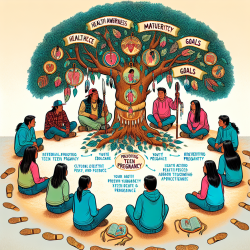Introduction
In the realm of teen pregnancy prevention, culturally attuned programs are proving to be essential, especially for Native American youth. The research article "My Journey: Development and Practice-Based Evidence of a Culturally Attuned Teen Pregnancy Prevention Program for Native Youth" highlights the importance of integrating cultural contexts into educational programs. This approach not only respects the unique cultural heritage of Native communities but also increases the effectiveness of these interventions.
The Need for Culturally Attuned Programs
Recent data indicates that the birth rate for Native American teens is significantly higher than that of their White counterparts. This disparity underscores the necessity for programs that are culturally relevant and responsive to the specific needs of Native youth. Traditional Western methods often fail to address the cultural nuances that are crucial for the success of such programs within tribal communities.
My Journey: A Culturally Integrated Curriculum
The "My Journey" curriculum is a shining example of how culturally attuned programs can make a difference. Developed through community-based participatory research (CBPR), this program incorporates traditional Native American values and teachings. It aims to enhance self-efficacy in sexual health decision-making among 6th to 8th graders.
- Core Concepts: The curriculum is built around five core concepts: the Medicine Wheel, Chain Reaction Model, traditional Native American values, sexual health, and goal setting.
- Interactive Learning: It includes interactive activities such as storytelling, traditional games, and role-playing to engage students effectively.
- Community Involvement: The program's development involved extensive input from community members, ensuring that it resonates with the cultural realities of the students.
Evaluating the Impact
The pilot study of "My Journey" revealed promising results. Students showed increased self-efficacy in refusing sex and demonstrated a greater understanding of the cultural and personal implications of their decisions. Teachers and facilitators appreciated the curriculum's adaptability and the ease with which students engaged with the material.
Future Directions
The success of "My Journey" highlights the potential for broader implementation and adaptation to other populations. By utilizing frameworks like the culture cube, practitioners can ensure that cultural elements are effectively integrated into educational programs, leading to better outcomes for diverse communities.
Conclusion
For practitioners seeking to improve their skills and outcomes, embracing culturally attuned approaches like "My Journey" is crucial. These programs not only honor the cultural heritage of the communities they serve but also provide a more effective path to positive youth development.
To read the original research paper, please follow this link: My Journey: Development and Practice-Based Evidence of a Culturally Attuned Teen Pregnancy Prevention Program for Native Youth.










